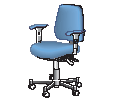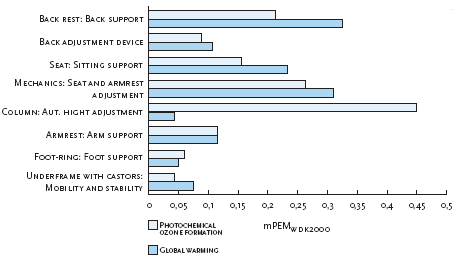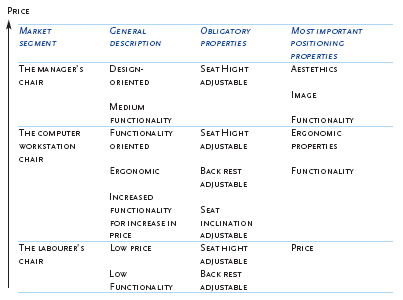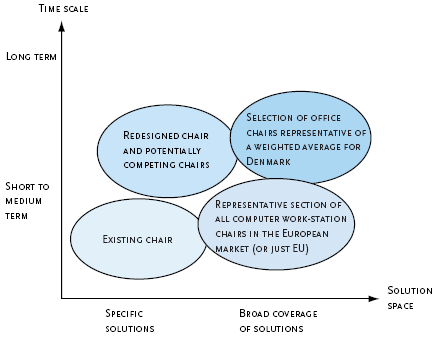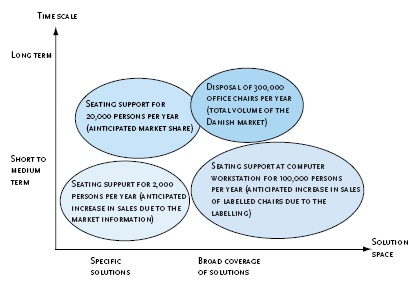|
The Product, Functional Unit and Reference Flows in LCA 3. Procedure for determining the object of study, the functional unit and the reference flows
Background 3.1 Determining the object of studyThe object of a life cycle assessment is the environmental impacts of a potential product substitution, i.e. the choice of one product instead of another (or the choice of a specific product instead of refraining from this product). The functional unit describes those properties of the product, which must be present for the studied product substitution to take place. These properties are in turn determined by the requirements in the market in which the product is to be sold. Step 1, 2 and 3 Therefore, the first steps in the five-step procedure are: Step 1: Describe the product by its properties Step 2: Determine the relevant market segment At the same time, the identified product functions and the market segment delimit the products that may be involved in a product substitution, so that the next step can be a further specification of the product alternatives to be included in the study: Step 3: Determine the relevant product alternatives 3.1.1 Step 1: Describe the product by its propertiesThe purpose of this step is to identify - out of all the properties of the studied product – those properties that shall be included in the functional unit and/or in the determination of the reference flow. The product properties may be divided in three groups depending on their importance: Three groups of product properties
The same product property may be placed in different groups in different markets (see section 3.1.2). A company-internal study, comparing different options in the product development, may define additional properties as obligatory for their own brand, although they are only regarded as a positioning properties on the general market (and would be determined as such in a more generic life cycle assessment comparing this brand with other brands). Properties Properties may be related to:
Functionality, aesthetics, and image characterise the primary services provided to the user. Technical quality and additional services ensure the primary services during the expected duration of these. Although durability may be included as part of the technical quality, it should be noted that most of the mentioned properties have a time aspect. Therefore, it is often important to specify the desired properties also in terms of the (minimum) period of time for which these properties are expected to last. For some products and/or properties, there may be a gradual decline in the expectations over time. The time aspect is treated in more detail in Chapter 4. Environmental properties may be included among the properties included in the functional unit. However, since the very purpose of a life cycle assessment is to study the environmental impacts of the products, it is not meaningful to state in advance that the studied products should have such general properties as "environmentally friendly" or "non-toxic." If environmental properties are included as obligatory, they must be expressed as specific properties, like "the seat and back rest must allow for recycling of the foam", so that it is possible to judge - prior to the life cycle study - whether a product has the required property. In developing more environmentally friendly products, it is important to understand the relationship between the individual properties and the environmental impact (see figure 4 for an example). If the environmental impacts are particularly linked to specific properties, it is especially important to consider whether these "environmentally costly" properties are obligatory or positioning, and whether it is possible to influence the trade-off made by the customer between the properties in question and the environmental properties of the product, e.g. by environmental information to the customer. Office chair example
Figure 4: The link between eight functional properties and two selected environmental impacts
Information sources Information on obligatory properties for a specific market segment can be obtained from:
Issues regulated in national and international legislation and standards will typically be obligatory properties. Office chair example
General obligatory properties of the office chair ISO (and coming CEN) standards for office chairs comprise both technical properties such as strength (e.g. ISO 7173), stability (e.g. ISO 7174-1), and safety (e.g. prEN 1335) and functional properties such as adjustments of seat height, depth and width, seat inclination, backrest height, width and inclination and arm rests length and width and more, see also Table 3. The role of non- obligatory properties The obligatory properties give a good description of what is required for products to substitute each other. However, the amount of substituted product or the interaction with other product systems may be determined by other properties. To ensure the equivalence between compared products, it is therefore necessary to analyse systematically all product properties and judge for each one whether it leads to differences in the amount of substituted product or in the interaction with other product systems. Office chair example
Non-obligatory properties of the office chairs If the chairs have different lifetimes (beyond the obligatory minimum of 5-7 years), this may lead to a difference in the amount of chairs necessary to fulfil the main function over time. If the seat cover on one chair needs more maintenance while the other is maintenance-free - or if one of the chairs lead to a need for adjustments in other office equipment while the other matches the existing office - additional functions of other systems (oil for maintenance, other office equipment) will have to be included to give a full description of the consequences of the product substitution. If several such additional properties can be identified, it is important to investigate whether one of the properties can be identified as the one determining the difference in performance. Examples of determining properties: In comparing different alternatives for hand drying, the technical properties of the tissue paper such as mass, absorption-power and tensile strength, may all influence the number of tissue papers used. However, these properties may all turn out to be irrelevant if in practice it is the dispenser design that determines the amount of paper used. Similarly, technical specifications of electrical hand driers, such as the volume of air and its temperature, may be irrelevant for comparing relative performance, if the actual operating time and energy consumption of the devices are fixed by other factors, e.g. built-in timers that give a fixed time per hand-drying event to be multiplied with the effect of the device. In comparing alternative types of walls in buildings, the property that determines the material consumption will often vary with the specific type of wall, depending on the chosen material or construction principle.This implies that it is not possible to identify a single determining property common to all the compared wall types. However, for each individual wall alternative, a determining property may be identified. For one wall type, the determining parameter may be durability, for another it may be strength, and for a third it may be sound or heat insulation. It should be noted that differences in performance between the compared alternatives often appear when choosing a (too) narrow product perspective, i.e. when studying intermediate products, components, or products that are otherwise very dependent on other products. Such performance differences, and the consequent need for adjustments (see section 3.3), can often be avoided by choosing a broader function-based perspective, i.e. based on the needs fulfilled by the products (e.g. "lighting" and "cooling of food") rather than based on the physical products themselves (e.g. "lamps" and "refrigerators"), see also the office chair example in section 3.1.2). Price as a relevant property It is normally assumed that the price (typically a positioning property), is approximately the same for all the compared alternatives, so that the overall economy of the buyer is not affected. However, in some situations, there is a significant price difference between the different alternatives at the level of the end consumer, so that it is relevant to consider that the money saved on the cheaper alternatives will eventually be liberated for alternative consumption in the customer segment affected by the price difference. If you wish to model the environmental impacts of this situation correctly, the product systems of the cheaper alternatives may have to be adjusted to include this additional consumption, following the procedure outlined in section 3.3. 3.1.2 Step 2: Determine the relevant market segmentThe purpose of this step is to identify the market segment in which the potential product substitution is taking place. Market segments Markets are typically differentiated <
Geographical segmentation The geographical segmentation of a market may be determined by differences in:
Office chair example
Geographical segmentation The market for office chairs is regionally segmented, which means that chairs sold in Europe are almost exclusively produced in Europe, with additional national sub- markets, so that the majority of chairs sold in Denmark are produced in Denmark. The markets are to a high extent regulated by legislative requirements. Figure 5. Geograhical market segments for the four examples in Figure 3
Temporal segmentation Temporal segmentation of markets is common for service products (e.g. peak hours and night hours in electricity consumption, rush hours in traffic and telecommunication, seasons in the tourist industry). For physical goods, markets are generally only segmented temporally when adequate supply or storage capacity is missing, either due to the nature of the product (e.g. food products), or due to immature or unstable markets, as has been seen for some recycled materials. This temporal segmentation should be distinguished from the fact that markets generally develop in time, e.g. governed by developments in fashion and technology, and that both geographical and temporal segmentation and customer segmentation therefore may change over time. This latter issue is dealt with in chapter 4. Each geographical market is typically divided into a number of customer segments. Customer segments Customer segments are generally defined in terms of clearly distinct function-based requirements, i.e. based on the needs fulfilled by the products rather than based on the physical products themselves. Very similar products may serve different needs and hence serve different markets. And very different products may serve the same need, thus being in competition on the same market. Thus, in a life cycle study for a specific company, the product group "office chairs" could be too broad a market delimitation. Instead, a specific use situation (and customer group) for office chairs must be identified. Alternatively, in more strategic contexts, the product group "chairs" may be seen as too narrow a definition, either because it excludes other ways of providing seating support, or because the chairs are only one component in a complete interior solution for the office. This definition is not arbitrary, but depends on whether the results of the life cycle study is to be applied for a specific or a more broadly defined market. Differences in customer requirements may be based on differences in the purchase situation, the use situation, customer scale, age, sex, education, status, "culture", attitudes etc. To have a practical relevance, segments must be:
Office chair example
Customer segments A small survey of the Danish office chair market has been made by acquiring marketing material from a number of suppliers, by telephone interviews with both suppliers and purchasers and by personal interviews with two leading manufacturers. From discussions with a Danish office chair manufacturer, it has become clear that at least four well distinguished customer segments exit, based on four different working situations.These may be named after the working situation in question: 1) the labourer's chair, 2) the computer workstation chair, 3) the manager's chair, and 4) the 24-hour chair.The latter constitutes only a very limited market, and is not addressed further here.The other markets are shown in Figure 6 together with some parameters that describe them. Figure 6. Segmentation of the office chair market, primarily based on the type of working situation
The labourer's chair is intended for the labourer, who is sitting on the chair at intervals only and not for many hours at the time, and who has intermittent standing and/or walking working positions.The computer workstation chair is intended for the worker, who is primarily sitting, and who is working behind a visual display unit (VDU), e.g. a computer, for a significant part of the day (at least two hours a day).The manager's chair is intended for the design-oriented person.This person is not working much on computer, writing, or drawing, but rather reading, talking on the telephone and the like.This chair could typically be for the employer or senior employee, to whom design, aestetics, and image/representativity to customers are important issues. According to the office chair manufacturer, there is only very little overlap between these groups of customers.This is much in line with the findings of the market survey, from which it is clear, that the chairs on the market are targeted to each of the outlined customer types. Furthermore, the grouping is emphasised by the specific legislative requirements for seat inclination for the computer workstation chair.The probability that a chair targeted for one segment should sell to a customer in one of the other segments is small, so that the product substitutability from segment to segment can be neglected.This implies that life cycle studies of office chairs should consider each of the market segments separately and not allow for comparisons between them. Information on market segmentation can typically be obtained from the marketing departments of the enterprises supplying products to the market. If information cannot be obtained directly from the market suppliers, possible secondary sources are:
The importance of considering the market conditions The above considerations of market segmentation and substitutability of products are of crucial importance in defining the scope of a life cycle study, when the compared products differ in appearance and/or functionality. Since the environmental impacts to be assessed are a direct consequence of the product substitutions, only product substitutions that can be expected to take place in practice should be included in the assessment. If the anticipated product substitutions do not occur in practice, the environmental impacts will be different from the ones assessed by the study. In parallel, the environmental impacts will also be different from the ones assessed by the study, if the assessment excludes product substitutions that can be expected to take place in practice. Therefore, it is important to include in the study all relevant product alternatives. This is treated in further detail in the following section. Due to the importance of these steps, the market segmentation is one of the places where it may be relevant to apply several alternative scenarios to reflect the limits of knowledge. Table 3. Selected technical properties of office chairs divided in obligatory (O) and positioning (P) in different market segments
3.1.3 Step 3: Determine the relevant product alternativesThe products that may be involved in a product substitution are delimited by the relevant market segment, as identified in the procedure described in the previous sections. Whether all of the possible products also shall be included in the study, depends on the goal of the study. Thus, the purpose of this step in the procedure is to determine what products shall be included in the study. An enterprise internal study may be performed for a very specific purpose, which gives a large degree of freedom to define what is regarded as relevant alternatives. Public applications, on the contrary, are typically aimed at influencing a predetermined market and must, therefore, relate to the products that are (expected to be) available on this market. For example, to determine ecolabelling criteria for office chairs, a study should include a representative selection of the product alternatives, which can substitute each other in the relevant market segment. A more narrow selection would be perceived as unfair to the excluded alternatives and not reflecting the true potential for environmental improvement. A broader selection would be seen as suggesting irrelevant alternatives and thus also as an unfair comparison. An enterprise internal study of the same chairs may - without causing such problems - be limited to study different alternatives within the product range of the enterprise itself or that of its closest competitors. Nevertheless, even enterprise internal studies should seek to reflect the actual consequences of the decision to be supported, and should therefore include the product alternatives, which are expected to be involved. Figure 7. Relevant product alternatives for the four examples in Figure 3.
3.2 Step 4: Define the functional unitThe functional unit is the central hub of any life cycle assessment, since it provides the reference to which all other data in the assessment are normalised. In a comparative study, the functional unit shall be the same for all the compared product systems. This is a prerequisite for ensuring equivalence among the product systems (see also section 3.3). In general, it is a prerequisite for defining the functional unit that the relevant market segment and the obligatory product properties have been determined, as described in the previous steps (section 3.1). Thus, what remains in step 4 is mainly the quantification: Step 4: Define and quantify the functional unit, in terms of the obligatory product properties required by the market segment. The functional unit should as far as possible relate to the functions of the product rather than to the physical product. For example, rather "seating support for one person working at a computer for one year" than "one computer workstation chair", rather "freezing capacity of 200 dm3 at -18ºC" than "one 200 dm3 refrigerator", rather "annual lighting of a work area of 10 square metres with 30 lux" than "bulbs providing 30000 lumen for one year". In this way, it is ensured that all obligatory properties - as well as the duration of the product performance - are addressed. As a reference unit, the size of the functional unit is - in principle - arbitrary. In general, it does not matter whether the office-chair study is normalised to seating support for 0.28 persons, 1 person, 1000 persons or 1.4 million persons. However, two concerns may be relevant when deciding on the size of the functional unit:
Scale of the study The studied product substitution may be small or large. A large substitution is defined as one, which affects the determining parameters for the overall technology development. Thereby, the studied substitution may in itself lead to new technologies being brought into focus. It can be a change so large that it affects the general trend in the market volume, e.g. from decreasing to increasing, whereby a new technology comes into play. It may also be a change so large that it overcomes a constraint which otherwise prevents the use of a specific technology. Further, a change may be so large that it affects the production costs of the involved technologies, e.g. through economies of scale. For such instances, it may be misleading if the functional unit is chosen independently of the actual scale of the studied substitution. When studying substitutions involving the entire market of a major product or process, e.g. studies dealing with the entire waste handling system of a region or studies dealing with legislation or standards for an entire sector, it is relevant to choose a functional unit of the same size as the affected market. Figure 8. The basic functional unit of the 4 examples in Figure 3, taking into account the scale of the studied substitution
Often, however, life cycle studies deal with small substitutions, which do not affect the overall trends in market volumes, nor the constraints on and production costs of the involved technologies. Therefore, the consequences of the substitution can be assumed linearly related to the size of the substitution so that the precise size of the functional unit will have no importance for the interpretation of the results. Ease of comparison For such small substitutions, another concern may be relevant: When presenting the outcome of the study, it should be as easy as possible to compare the outcome to something well-known to the reader. For this reason, the environmental exchanges are typically normalised to the annual exchanges from a region, from an average person living in this region (person-equivalents as in the EDIP-method), or from the average monetary expenditure in this region. To ease this normalisation, and to present the results in an easily comprehensible way, it may be an advantage to set the size of the functional unit equal or close to the annual per capita consumption of the studied product in the studied market segment. Expanding the functional unit In some instances, two products may be so closely linked that the separation of some of the processes in their life cycle may lead to an increase in uncertainty. If all the analysed product systems provide the same amount of such linked products, this additional uncertainty may be avoided by including both products in the functional unit. Example: Inventory result relates to the result of adding or subtracting one functional unit The outcome of the study, as e.g. presented in the inventory tables, represents the environmental exchanges resulting from adding or subtracting one functional unit compared to the other systems studied, or by fulfilling the performance described by the functional unit compared to not fulfilling this performance. It should not be understood to represent the environmental exchanges of the functional unit in itself, since the result may to a larger or minor degree come from interactions with other product systems (see also the text on system expansion in section 3.3)
Example: 3.3 Step 5: Determine the reference flows The final step in the procedure is:Step 5: Determine the reference flow for each of the product systems. A reference flow is a quantified amount of the product(s), including product parts, necessary for a specific product system to deliver the performance described by the functional unit. For a composite product, the reference flow will typically be identical to the parts list of the product, multiplied by a factor to scale it to the functional unit. The purpose of the reference flows is to translate the abstract functional unit into specific product flows for each of the compared systems, so that product alternatives are compared on an equivalent basis, reflecting the actual consequences of the potential product substitution. The reference flows must take into account all those properties (whether obligatory, positioning, or market-irrelevant), which were identified in step 1 (section 3.1.1) as determining for a performance difference. It is not just the obligatory product properties that determine the amount of substituted product or the interaction with other product systems. For example, the ease of handling and cleaning a beverage container (positioning and non-market relevant properties, respectively) can influence the amount of car-driving on behalf of the consumer and the type and amount of cleaning agent, respectively. A relative measure of the substitution For each of the properties identified as having a determining influence on the amount of product necessary, a relative measure must be determined of the extent to which the studied products are expected to substitute each other. Examples: • 5 times 3 bulbs of 3000 lumen with a lifetime of 10000 hours each, equal to When comparing paints with the same obligatory product properties (e.g. minimum 98% opacity and minimum 5 years durability), differences in covering ability (a positioning property) will determine the reference flow of the different paints, e.g. a ratio of 2.3 litres of paint A to 1.9 litres of paint B to 1.7 litres of paint C etc. In comparing different alternatives for hand drying, the dispenser design may determine the size of the reference flow of tissue paper. In comparing 0.5-litres one-way bottles with 0.4-litres returnable bottles, the amount of bottles needed to fulfil the same function of protecting a certain amount of beverage is determined by two properties: the volume and the return rate of the returnable bottles (with a return rate of 90%, a reference flow of 125 returnable bottles would protect the same amount of beverage as the reference flow of 1000 one-way bottles). Appropriate tests and measures When determining the relative performance of different products, test conditions and measurement methods should be appropriate to the intended comparison. It may not always be adequate to use the information from the producer. Examples: System expansion For each of the properties identified as leading to differences in the way that the compared systems interact with other systems, the system boundaries must be modified to avoid this difference. This is parallel to the procedure for handling co-products, which also lead to a need for modifying the system boundaries to include the processes affected by the differences in amounts of co-products from the analysed systems (see also the technical report: "Market information in LCA"). What is important in this step, is the description of the difference between the analysed products and a general description of the system modifications necessary to avoid this difference. The description must include any difference, which leads to additional processes in one or more of the analysed product systems. Also future processes, such as additional needs for maintenance, replacements, waste treatment, or recycling of raw materials must be included in the description, whenever these processes are planned or can be foreseen to be necessary. This is one of the places where it may be relevant to apply several alternative scenarios to reflect the limits of knowledge. Examples: In the above example, the difference in lifetime of the two bulbs was simply taken into account when calculating the relative performance of the two light bulbs.While this adjustment may be an acceptable procedure for a comparison of light bulbs, more long-lived products, such as refrigerators with life times of 10 or 20 years it require that technology development is taken into account. One refrigerator with a lifetime of 20 years cannot simply be compared to two successive, present-day refrigerators with a lifetime of 10 years.The refrigerators available 10 years from now are certain to be more energy efficient (i.e. having lower energy input per functional unit) than the present, so the energy efficiency of the second refrigerator of the 10 + 10 years alternative must be determined by forecasting, while the energy efficiency of the 20 years alternative is fixed. Including changes in customer behaviour It should be noted that the behaviour of the customer may be affected differently by the different product alternatives. This is especially relevant when studying consumer products and may often significantly affect the outcome of the study. Thus, it is necessary to include the entire change in consumer behaviour in the reference flow. Examples: In the comparison of 0.5-litres one-way bottles with 0.4-litres returnable bottles, it may - as mentioned in section 3.2 - be necessary to investigate how the difference in volume affects the consumption of the beverage. If the consumer regards 1 bottle equal to 1 bottle, the total consumption of beverage will decrease when the returnable bottles are introduced. In this case, the packaging cannot be studied independent of its contents.The goal of the study may then have to be redefined to allow a comparison of beverage plus packaging taking into account the changes in consumption. Including effects of price differences If there is a large price difference between different product alternatives at the end consumer level, and you wish to model the environmental impacts of this situation correctly, the reference flow of the cheaper alternatives may - as mentioned in section 3.1.1 - have to be adjusted to include the alternative spending of the money saved. This addition should ideally model the marginal spending by utilising information on what products increase their market volume when the spending increases, as presented in figure 9. Figure 9. The distribution of 1% growth in private consumption in the period 1977-1997 in Denmark. Calculated by the Copenhagen
Note that this is generally only relevant for price differences at the end consumers, since at enterprises the price differences seldom have any lasting effects due to the tendency of marginal profits and wages to level out across all industries. A similar adjustment may be required if the there is a large difference between the product alternatives in terms of time consumption at the end consumer level. In this case, the timesaving alternatives may have to be adjusted to include the changes in overall behaviour as a result of the additional time available in these alternatives. Details of system expansion can be postponed To determine exactly what additional processes are to be included as a result of differences between the analysed systems often requires more detailed investigation. This investigation, which follows the same procedure as for determining the system expansions related to co-products, does not have to be finalised as part of the procedure described here. Similarly, the detailed description of the additional processes may be referred to the general description of what is included in and excluded from the analysed systems. Reporting of system expansions For the final reporting, it is appropriate to report all system expansions in one place, both those relating to product properties and those related to co-products. In order to avoid misunderstandings as to the extent of the systems described by the functional unit, the appropriate place for reporting all system expansions (including those from handling of co-products) is in close conjunction with the description of the functional unit. Also, it is recommended that in the presentation of the outcome of the study (inventory tables etc.), the influences of system expansions should be presented separately. 3.4 Summary of the procedure in checklist form Figure 10. Information flow between the five steps in the procedure
Step 1: Describe the product by its properties
Step 2: Determine the relevant market segment
Step 3: Determine the relevant product alternatives
Step 4: Define and quantify the functional unit, in terms of the obligatory product properties required by the market segment.
Step 5: Determine the reference flow for each of the product systems.
|
||||||||||||||||||||||||||||||||||||||||||||||||
